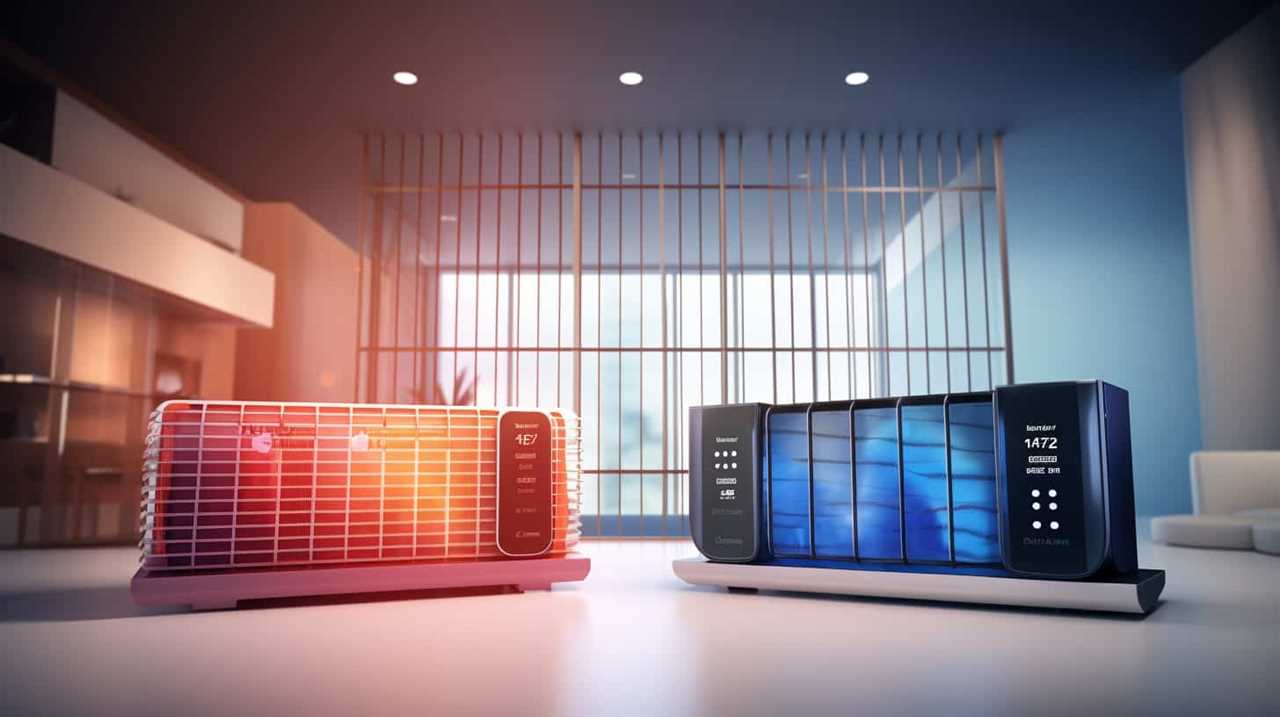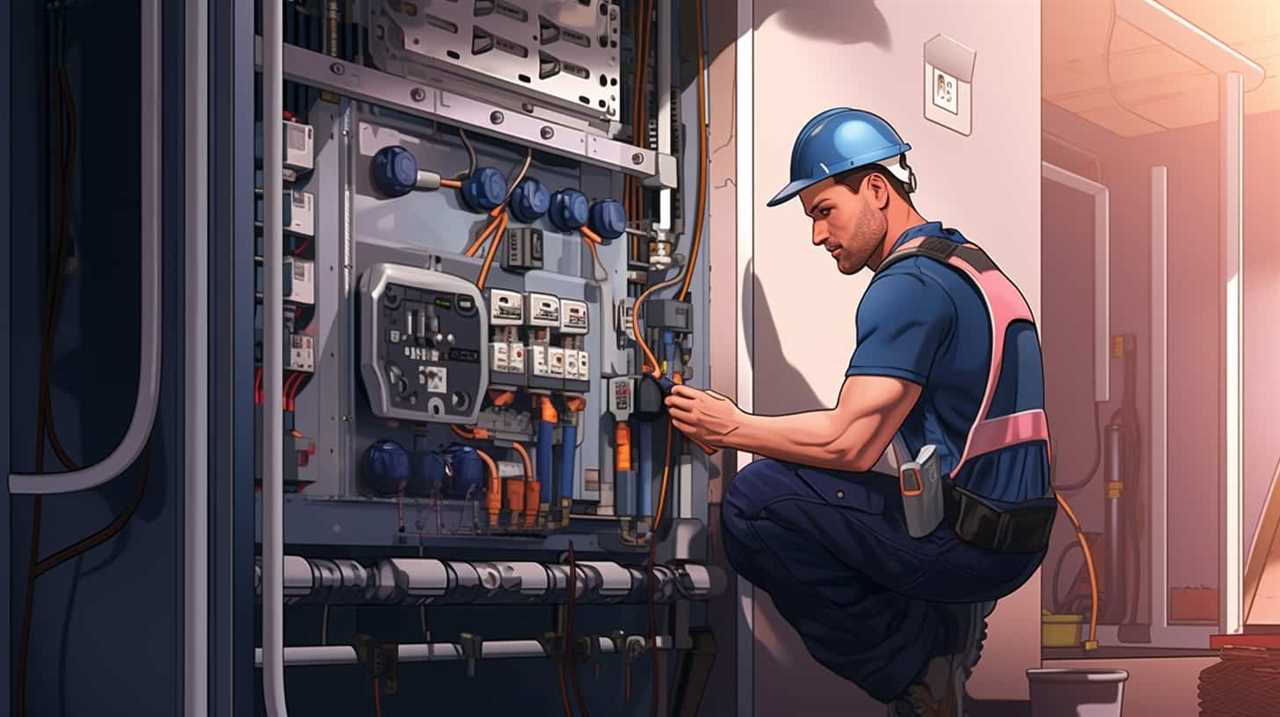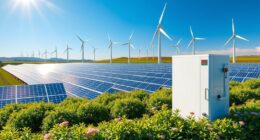Thinking about putting your money into a geothermal heat pump? Hold off on deciding until we reveal the actual expenses associated with these cutting-edge systems.
In this article, we will provide you with a comprehensive analysis of the upfront costs, installation expenses, and underground loop system pricing.
We will also explore the importance of proper sizing, budgeting for maintenance and repairs, financing options, and the return on investment.
Compare geothermal heat pumps to other systems and gain mastery over your heating and cooling choices.

Key Takeaways
- Geothermal heat pumps require an initial investment and installation expenses, including equipment costs, installation labor and materials, and drilling geothermal wells.
- Geothermal heat pumps provide long-term energy savings, with significant reductions in energy consumption compared to traditional systems.
- Financing options, such as loans, rebates, and tax incentives, are available to help mitigate the upfront costs of geothermal heat pump installation.
- The cost of underground loop systems, a crucial part of geothermal heat pump installation, can vary based on property size, soil conditions, and loop configuration.
The Initial Investment: Understanding the Upfront Costs
When we consider the initial investment of geothermal heat pumps, it’s important to understand the upfront costs. To truly grasp the financial commitment, we must break down the components of the initial investment.
The initial investment breakdown consists of equipment costs, installation expenses, and the cost of drilling geothermal wells. Equipment costs typically make up the largest portion, ranging from $10,000 to $25,000 depending on the size and efficiency of the system.
Installation expenses, including labor and materials, can range from $5,000 to $15,000. The cost of drilling geothermal wells, essential for harnessing the earth’s heat, can be a significant expense, ranging from $10,000 to $30,000.
However, it’s important to note that there are financing options available to help mitigate these upfront costs, such as loans, rebates, and tax incentives. By carefully considering the initial investment breakdown and exploring financing options, individuals can make informed decisions about geothermal heat pumps.

Installation Expenses: What to Expect
When considering the installation expenses of geothermal heat pumps, it’s important to understand the breakdown of the initial investment. This includes the cost of the equipment, labor, and any additional materials needed for the installation.
However, it’s essential to keep in mind the long-term energy savings that geothermal heat pumps provide, which can offset the upfront costs over time.
Additionally, there are financing options available that can help make the installation expenses more manageable.
Initial Investment Breakdown
As we delve into the initial investment breakdown of geothermal heat pumps, let’s discuss what to expect in terms of installation expenses. When evaluating the lifecycle costs of geothermal heat pumps, it’s crucial to have a thorough understanding of the payback period. Here are the key factors to consider:

Equipment Costs:
Geothermal heat pump unit: This typically accounts for the largest portion of the installation expenses. The cost can vary depending on the size and efficiency of the unit.
Ground Loop System: The cost of drilling boreholes or installing horizontal loops can significantly impact the overall installation expenses.
Additional Installation Expenses:

Ductwork modifications: If your existing ductwork isn’t compatible with the geothermal system, modifications or replacements may be necessary.
Electrical upgrades: Geothermal heat pumps require a dedicated electrical circuit, so electrical upgrades might be needed.
Long-Term Energy Savings
To fully understand the long-term energy savings of geothermal heat pumps, we need to consider the installation expenses and what to expect.
When evaluating efficiency, geothermal heat pumps are known to provide significant energy savings compared to traditional heating and cooling systems. A study conducted by the Department of Energy found that geothermal heat pumps can reduce energy consumption by up to 45% compared to air-source heat pumps and up to 72% compared to electric resistance heating. This translates to substantial cost savings on energy bills over the lifespan of the system.

Additionally, geothermal heat pumps have a lower environmental impact compared to other heating and cooling options. They produce fewer greenhouse gas emissions and have a smaller carbon footprint, contributing to a more sustainable and eco-friendly living environment.
Financing Options Available
Our financing options and the installation expenses are something we need to consider when discussing the true cost of geothermal heat pumps. Finding the right geothermal heat pump financing can help make the upfront costs more manageable.
Here are a few financing options to consider:
Traditional Loans: Many banks and lending institutions offer loans specifically for geothermal heat pump installations. These loans typically have competitive interest rates and flexible repayment terms.

Energy Efficiency Programs: Some utility companies and government agencies offer financial incentives and rebates for installing geothermal heat pumps. These programs can help offset the installation expenses.
When comparing financing options, it’s important to consider factors such as interest rates, repayment terms, and eligibility requirements. By carefully evaluating these options, you can find the best financing solution for your geothermal heat pump installation.
With the financing in place, we can now explore the cost of underground loop systems.
Exploring the Cost of Underground Loop Systems
When exploring the cost of underground loop systems for geothermal heat pumps, it’s important to consider the installation expenses breakdown and the long-term cost savings.

Understanding the breakdown of installation expenses allows for a more accurate assessment of the initial investment.
Considering the long-term cost savings helps evaluate the overall economic benefits of geothermal heat pumps.
Installation Expenses Breakdown
As we delve into the topic of installation expenses breakdown, let’s explore the cost of underground loop systems.
Underground loop installation is a crucial part of the geothermal heat pump installation process. Understanding the expenses associated with this component is essential for homeowners considering this renewable energy solution.

Here is a breakdown of the costs involved:
Material costs:
High-density polyethylene (HDPE) pipes
Grout or thermal enhancement materials

Labor costs:
Excavation and trenching
Loop layout and placement
Fusion welding of pipes

Backfilling and site restoration
These costs can vary depending on factors such as the size of the property, soil conditions, and chosen loop configuration. It’s advisable to consult with experienced professionals to get accurate estimates specific to your project.
Long-Term Cost Savings
Exploring the long-term cost savings of underground loop systems involves understanding the potential energy efficiency and operational benefits.
When considering the long-term cost analysis of geothermal heat pumps, it’s important to factor in the maintenance of the system. Geothermal heat pump maintenance typically involves regular inspections, filter changes, and occasional repairs.

While there may be some costs associated with maintenance, these are often outweighed by the significant energy savings over time.
Additionally, underground loop systems have a longer lifespan compared to traditional heating and cooling systems, reducing the need for frequent replacements and further increasing the cost savings.
The Importance of Proper Sizing: How It Impacts the Price
We can’t underestimate the significance of proper sizing when it comes to how it affects the price of geothermal heat pumps. Proper maintenance and system efficiency are two key factors that are closely linked to proper sizing.
Here’s how proper sizing impacts the price:

Energy Efficiency: When a geothermal heat pump is properly sized, it operates at peak efficiency, resulting in lower energy consumption and reduced utility bills.
Long-Term Savings: Investing in a properly sized geothermal heat pump ensures that the system operates optimally, minimizing the need for repairs and replacement parts. This translates to long-term cost savings.
Improved Performance: Proper sizing ensures that the geothermal heat pump delivers the desired heating and cooling capacity, leading to improved overall performance and comfort.
Extended Lifespan: When a system is properly sized, it operates within its designed parameters, reducing wear and tear and prolonging its lifespan.

Maintenance and Repairs: Budgeting for Long-Term Care
Let’s discuss how to budget for long-term care when it comes to maintenance and repairs of geothermal heat pumps. Proper maintenance and regular repairs are essential to keep your geothermal heat pump functioning efficiently and prolong its lifespan. However, it is important to consider the long-term maintenance costs and budget accordingly. Here is a breakdown of the potential costs involved in maintaining and repairing a geothermal heat pump:
| Maintenance Task | Frequency | Cost Range |
|---|---|---|
| Annual Check-up | Yearly | $100 – $300 |
| Filter Replacement | Every 3 months | $20 – $50 |
| System Flush | Every 5 years | $500 – $1,000 |
| Major Repairs | Occasional | $1,000 – $5,000 |
Energy Savings: Calculating the Financial Benefits
To accurately assess the financial benefits of geothermal heat pumps, we need to consider the energy savings that can be achieved. Geothermal heat pumps are known for their energy efficiency, which translates into significant cost savings over time. When calculating energy savings, it’s essential to consider the following factors:
Energy consumption: Geothermal heat pumps use less energy compared to traditional heating and cooling systems, resulting in lower utility bills.
System lifespan: Geothermal heat pumps have a longer lifespan than conventional systems, reducing the need for replacements and associated costs.

By calculating energy savings based on these factors, homeowners can determine the financial benefits of installing a geothermal heat pump.
The next section will delve into evaluating tax incentives and rebates, which further enhance the financial advantages of geothermal heat pumps.
Evaluating Tax Incentives and Rebates
When evaluating the true cost of geothermal heat pumps, it’s important to consider the potential tax incentives and rebates available. These cost-saving incentives can significantly offset the initial investment and make geothermal heat pumps more financially viable.
Additionally, many governments and utility companies offer rebates for implementing energy-efficient solutions, further reducing the overall cost of installing a geothermal heat pump system.

Cost-Saving Incentives Available
We’ve found that exploring the cost-saving incentives available for geothermal heat pumps, such as evaluating tax incentives and rebates, can greatly impact the overall affordability of this energy-efficient heating and cooling system. By taking advantage of these incentives, homeowners can’t only reduce their upfront costs but also enjoy long-term savings on their energy bills.
Here are some key cost-saving incentives to consider:
Energy Efficiency Programs: Many local and state governments offer energy efficiency programs that provide financial incentives for installing geothermal heat pumps. These programs often include rebates, low-interest loans, and grants to help offset the installation costs. These programs are designed to promote the adoption of energy-efficient technologies and reduce greenhouse gas emissions.
Renewable Energy Grants: There are also various renewable energy grants available at the federal, state, and local levels. These grants can provide significant financial assistance for homeowners looking to install geothermal heat pumps. These grants aim to encourage the use of renewable energy sources and support the transition to a more sustainable energy future.

Rebates for Energy Efficiency
By evaluating tax incentives and rebates, we can uncover the potential savings and benefits that homeowners can enjoy when installing geothermal heat pumps. Energy efficiency rebates and government incentives play a crucial role in making geothermal heat pumps more affordable and attractive to homeowners.
These incentives are designed to encourage the adoption of energy-efficient technologies and reduce the overall energy consumption of residential buildings. With energy efficiency rebates, homeowners can receive financial incentives for installing geothermal heat pumps, which can help offset the upfront costs of the system.
Additionally, government incentives such as tax credits and grants can further reduce the cost of installation and provide long-term savings on energy bills. These incentives not only benefit homeowners but also contribute to national energy conservation efforts and reduce greenhouse gas emissions.
Therefore, it’s essential for homeowners to explore and take advantage of the various energy efficiency rebates and government incentives available to make geothermal heat pumps a more cost-effective and sustainable choice.

Financing Options: Making Geothermal Heat Pumps Affordable
One of the most common ways we can make geothermal heat pumps more affordable is through financing options. By taking advantage of geothermal heat pump grants, homeowners can receive financial assistance to offset the initial costs of installation. These grants, provided by government agencies and organizations, aim to promote the adoption of renewable energy systems and reduce greenhouse gas emissions.
Another financing option is geothermal heat pump leasing, where homeowners can lease the equipment instead of purchasing it outright. This allows for a lower upfront cost and spreads the expense over a longer period of time.
By exploring these financing options, homeowners can make geothermal heat pumps more accessible and affordable.
Now, let’s move on to assessing the return on investment (ROI) to understand the long-term benefits of geothermal heat pumps.

Assessing the Return on Investment (ROI)
Let’s evaluate the return on investment (ROI) to determine the long-term benefits of geothermal heat pumps.
When evaluating installation costs, it’s important to consider the energy efficiency of geothermal heat pumps. While the upfront costs may be higher compared to traditional heating and cooling systems, the long-term savings in energy bills can make up for it.
Geothermal heat pumps are known for their high energy efficiency, with some systems achieving an efficiency rating of over 400%. This means that for every unit of electricity the geothermal heat pump consumes, it can produce over four units of heat or cooling. This level of efficiency translates into significant savings on energy bills over the lifespan of the system.
With these cost savings, geothermal heat pumps can provide a strong return on investment.

Now, let’s compare geothermal heat pumps to other heating and cooling systems to further understand their benefits.
Comparing Geothermal Heat Pumps to Other Heating and Cooling Systems
We frequently compare geothermal heat pumps to other heating and cooling systems to determine their advantages. When it comes to efficiency, geothermal heat pumps outperform traditional systems by a significant margin. Studies have shown that geothermal heat pumps can achieve efficiencies of up to 400%, meaning they can provide four units of heating or cooling for every unit of electricity consumed. In comparison, the most efficient air-source heat pumps can only achieve efficiencies of around 250%.
Additionally, geothermal heat pumps have a lower environmental impact compared to other systems. They don’t emit any greenhouse gases during operation and require less electricity, reducing overall carbon emissions. This makes geothermal heat pumps an environmentally friendly choice for heating and cooling needs.
Geothermal heat pump efficiency:

Geothermal heat pumps achieve efficiencies of up to 400%.
Air-source heat pumps achieve efficiencies of around 250%.
Environmental impact of geothermal heat pumps:
Geothermal heat pumps don’t emit greenhouse gases.

Geothermal heat pumps require less electricity, reducing carbon emissions.
Considerations for Geothermal Heat Pump Retrofitting Projects
When considering geothermal heat pump retrofitting projects, our team must carefully evaluate the existing infrastructure and determine the feasibility of implementing the system. Retrofitting an existing building with a geothermal heat pump can offer numerous benefits, including reduced energy costs, increased comfort levels, and environmental sustainability. However, there are also challenges that need to be addressed during the retrofitting process. These challenges include the need for adequate space for the geothermal loop system, potential limitations of the existing electrical system, and the upfront cost of installation. To help illustrate these considerations, we have created a table below:
| Considerations | Geothermal Heat Pump Retrofitting Projects |
|---|---|
| Space Requirements | Adequate space is needed for the geothermal loop system, which can vary depending on the size of the building and the desired heating and cooling capacity. |
| Electrical System | The existing electrical system may need to be upgraded to accommodate the additional electrical load of the geothermal heat pump. |
| Cost | Retrofitting a building with a geothermal heat pump can require a significant upfront investment, although the long-term energy savings can help offset this cost over time. |
| Environmental Impact | Geothermal heat pumps are a more sustainable heating and cooling option, as they utilize renewable energy from the earth’s heat, reducing greenhouse gas emissions. |
| Maintenance | Geothermal heat pumps require regular maintenance to ensure optimal performance and longevity, including system checks, filter cleaning, and fluid level monitoring. |
Frequently Asked Questions
Are There Any Tax Incentives or Rebates Available for Geothermal Heat Pump Installations?
There are tax incentives and government rebates available for geothermal heat pump installations. These incentives can help offset the initial costs and make the investment more financially feasible in the long run.
How Does the Initial Investment of a Geothermal Heat Pump Compare to Other Heating and Cooling Systems?
When comparing the initial investment of a geothermal heat pump to other systems, we conducted a cost effectiveness analysis. The results showed that geothermal heat pumps are more cost-effective in the long run.

What Are the Long-Term Maintenance and Repair Costs Associated With Geothermal Heat Pumps?
Long-term maintenance costs and repair expenses for geothermal heat pumps vary depending on factors such as system size, age, and installation quality. Regular maintenance can help minimize repair costs and ensure optimal performance.
Can Geothermal Heat Pumps Be Retrofitted Into Existing Homes or Buildings?
Yes, geothermal heat pumps can be retrofitted into existing homes or buildings. The installation process involves drilling boreholes and connecting the system to the existing heating and cooling infrastructure. Retrofitting offers benefits such as energy efficiency and reduced carbon emissions.
What Financing Options Are Available to Make Geothermal Heat Pumps More Affordable?
There are various geothermal heat pump financing options available to make them more affordable. We’ve analyzed the data and found that these options can greatly improve geothermal heat pump affordability for homeowners and businesses alike.
What Are the Hidden or Unexpected Costs of Geothermal Heat Pumps?
Installing geothermal heat pumps may seem cost-effective, but uncover astonishing costs geothermal heat pumps hide. Beyond initial investment, there are expenses for drilling, loop installation, and retrofitting existing ductwork. Maintenance and repairs can be pricier due to specialized equipment. Additionally, homeowners might face unexpected costs if their property’s geological characteristics are not suitable, requiring adjustments or alternate systems.
Conclusion
In the quest for sustainable and cost-effective heating and cooling solutions, geothermal heat pumps may be the hidden gem. Although the initial investment and installation expenses may seem daunting, the long-term benefits and potential for savings make it a worthwhile choice.

With proper sizing and regular maintenance, these systems can provide reliable comfort while significantly reducing energy consumption. Consider the true cost of geothermal heat pumps and explore financing options to make this eco-friendly option a reality for your home or business.









